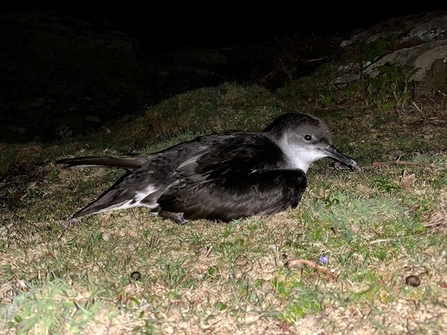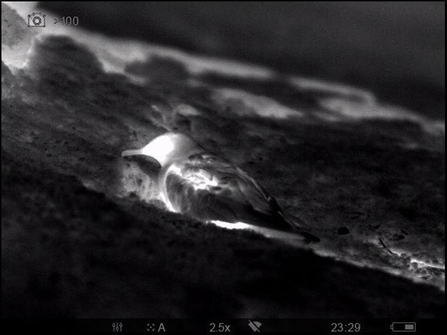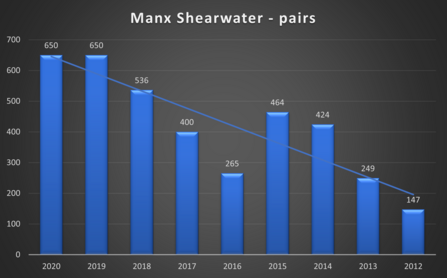Sponsorship to purchase a thermal camera to help monitor the growing population of Manx Shearwaters on the Calf of Man has been provided by the Curraghs Wildlife Park and through a ‘lockdown’ birdwatching challenge by local birder Tim Earl. We are also grateful to Simpson Brothers who supplied the unit at cost price.
Curraghs Wildlife Park Conservation Fund supports important research into Manx Shearwater population on the Calf of Man.
“Thermal” image of a Manx Shearwater

Manx Shearwater
The Calf’s Bird Warden, Aron Sapsford, explains how this new technology will assist in the important research work being carried out into this enigmatic species.
“Monitoring Manx Shearwaters is far from straightforward as the adult birds only come ashore during the cover of darkness, when they are at less risk from predators, before disappearing down their nesting burrows. Each year, we undertake a survey of breeding numbers through a sample call-back study that enables us to estimate the number of occupied burrows within the Calf’s largest Shearwater colony. However, it would require a huge amount of time, effort and resources to carry out this method across the whole of the Calf. Recording bird activity and numbers is relatively straightforward if you can see them, however the Manx Shearwaters nocturnal habits make this almost impossible – until now. The thermal camera is a real ‘game changer’ allowing us the opportunity to watch birds coming ashore at night and seeing what they do and where they go. They are rather ungainly on land, reminiscent to a penguin, which also allows the opportunity for us to catch the adults for ringing. This provides the ability for us to follow individual life histories, as well as providing a measure of population size through capture and recapture rates”.

“Thermal” image of a Manx Shearwater
The Calf of Man is an important place for the Manx Shearwater Puffinus puffinus. The species English name was first recorded in 1676 and refers to the nesting of the species on the Calf, where historical records indicate that tens of thousands of birds once bred. During the 17th Century, as many as 10,000 young were ‘harvested’ annually for food and oil. They were also used as ground rent when, in 1644, the Earl of Derby took over the Calf and ‘paid’ Richard Stevenson, who had been farming the Calf, a yearly rent of 500 Manks Puffins. The use of the name ‘Puffins’ referred to the cured carcass of the fat nestling shearwater. This ‘persecution’ continued for many years but appeared to have little or no detrimental effect on the numbers breeding on the Calf, however the accidental introduction of the Brown Rat Rattus norvegicus (Longtails) to the islet, as the result of a shipwreck in 1781 caused a ‘catastrophic’ decline. By the beginning of the nineteenth century, the shearwater colonies on the Calf were all but wiped out, however various efforts to eradicate or reduce the effects of the ‘Longtails’ from 1979 onwards would appear to have had some success and in 2000 breeding was again confirmed. In 2012 the Manx Shearwater Recovery Project was initiated, and a structured programme of baiting and monitoring was started, as part of a collaboration between Manx National Heritage, DEFA, the Manx Wildlife Trust and several other NGO’s.

Population growth since the start of the Manx Shearwater Recovery Project
Although eradication of the ‘Longtails’ has not been entirely successful, it has reduced them sufficiently that only one or two individuals now occur each year. This has allowed the Manx Shearwaters to recolonise the Calf, with the population rising to over 600 pairs in 2019.
